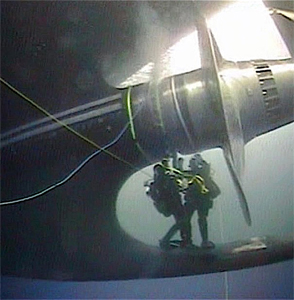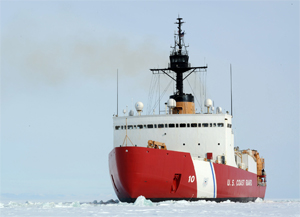U.S. Coast Guard officials say serious malfunctions aboard the heavy icebreaker Polar Star during its annual Operation Deep Freeze resupply mission to Antarctica highlight a dire need to have backup icebreakers in operation.
Although the 43-year-old ship spent months in dry dock for upgrades, maintenance and repairs last spring and summer as it does each year, it still ran into difficulties making the 11,200-nautical-mile voyage from Seattle to McMurdo Sound and back this year.
The problems ranged from an incinerator room fire and a leaking propeller shaft seal — requiring divers to make repairs in frigid underwater conditions — to wire damage in a switchboard and the failure of one the evaporators used to make drinkable water.
Lt. Cmdr. Stephen Brickey, public affairs officer for the Coast Guard’s Pacific Area, said the ship is running into such annual problems because it’s operating well beyond its expected 30-year-old service life “in one of the most challenging environments on Earth.”
“And the act of icebreaking itself places incredible stress on a ship,” he added.
This year, the 399-foot, 13,000-ton Polar Star broke through 18 miles of 6- to 10- foot-thick ice to open a channel for supply ships to make their way to a National Science Foundation station at McMurdo. The annual delivery allows Antarctic stations to stay operational year-round.
It’s getting more challenging for the aging ship to carry out this mission each year, Brickey said, but Polar Star needs to be able to hang in there until 2023, when a new polar security cutter — the ships recently were renamed from heavy icebreaker to emphasize their national importance and strategic value — is expected to be completed.
“It’s not a good situation,” Brickey said. “But we’re pleased to have funding for a replacement and a second one. … We need to grow our capability so that we’re not in the same position in 10 years.”
 |
|
U.S. Coast Guard divers repair a leak in the shaft seal of the heavy icebreaker Polar Star during its recent mission to Antarctica. A hyperbaric chamber on loan from the U.S. Navy allowed divers to make emergency repairs and inspections of the ship’s hull. |
|
Courtesy U.S. Coast Guard |
The Coast Guard plans to increase its icebreaking fleet with six new polar security cutters to ensure a continued U.S. presence and access to the polar regions. But it’s a time-consuming process that is just getting started in earnest this year.
“The Coast Guard and Navy are currently evaluating industry proposals and remain on track to award a contract for detail design and construction in 2019,” Brickey said. “The (fiscal year) 2019 appropriation is sufficient to keep this vital program on schedule.”
In the FY 2019 budget, Congress appropriated $655 million to begin construction of a new polar security cutter this year, with another $20 million appropriated for long-lead-time materials to build a second.
The only other U.S. polar icebreaker currently in operation is the 420-foot medium icebreaker Healy, commissioned in 2000, which does not have the capabilities of Polar Star.
In the event of a catastrophe, such as Polar Star getting stuck in Antarctica, the Coast Guard would have “absolutely no bench strength,” said Lt. Cmdr. Cory Riesterer, deputy of Cutter Forces for the Pacific Area. “It’s so remote that we’d have to call for another nation to help.”
In the Arctic, Brickey said the United States is competing for “sovereign rights” as the region becomes increasingly accessible and global interests in energy, trade and subsistence continue to intensify.
“The Coast Guard is our nation’s most visible, agile and adaptive force available to assert U.S. sovereignty, represent national interests and vigorously compete for advantage in the region,” he said. But with only one operational heavy icebreaker, “America is limited in its ability to project a presence … and it is falling behind other nations, such as Russia and China, in a region with critical geostrategic value.”
By contrast, Russia operates more than 50 icebreakers, including some that are nuclear powered, according to the Coast Guard. China, declaring itself a “near-Arctic state,” has a second polar icebreaker under construction.
“It’s noteworthy that all the preparation and hard work yields a successful (Operation Deep Freeze) mission every year,” Riesterer said. “But that good success story is in jeopardy. How long can we do it with such an aging fleet? It gets more fragile each year.”

